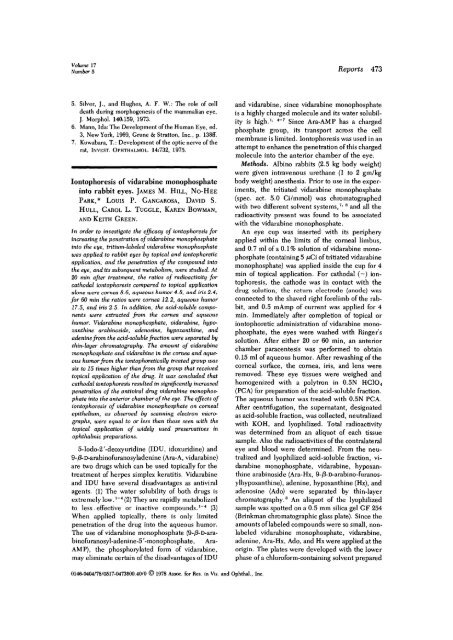Ocular retardation (or) in the mouse.
Ocular retardation (or) in the mouse.
Ocular retardation (or) in the mouse.
You also want an ePaper? Increase the reach of your titles
YUMPU automatically turns print PDFs into web optimized ePapers that Google loves.
Volume 17<br />
Number 5 Rep<strong>or</strong>ts 473<br />
5. Silver, ]., and Hughes, A. F. W.: The role of cell<br />
death dur<strong>in</strong>g m<strong>or</strong>phogenesis of <strong>the</strong> mammalian eye,<br />
J. M<strong>or</strong>phol. 140:159, 1973.<br />
6. Mann, Ida: The Development of <strong>the</strong> Human Eye, ed.<br />
3, New Y<strong>or</strong>k, 1969, Grune & Stratton, Inc., p. 138ff.<br />
7. Kuwabara, T.: Development of <strong>the</strong> optic nerve of <strong>the</strong><br />
rat, INVEST. OPHTHALMOL. 14:732, 1975.<br />
Iontoph<strong>or</strong>esis of vidarab<strong>in</strong>e monophosphate<br />
<strong>in</strong>to rabbit eyes. JAMES M. HILL, NO-HEE<br />
PARK,* LOUIS P. GANGAROSA, DAVID S.<br />
HULL, CAROL L. TUGGLE, KAREN BOWMAN,<br />
AND KEITH GREEN.<br />
In <strong>or</strong>der to <strong>in</strong>vestigate <strong>the</strong> efficacy of iontoph<strong>or</strong>esis f<strong>or</strong><br />
<strong>in</strong>creas<strong>in</strong>g <strong>the</strong> penetration of vidarab<strong>in</strong>e monophosphate<br />
<strong>in</strong>to <strong>the</strong> eye, tritium-labeled vidarab<strong>in</strong>e monophosphate<br />
was applied to rabbit eyes by topical and iontoph<strong>or</strong>etic<br />
application, and <strong>the</strong> penetration of <strong>the</strong> compound <strong>in</strong>to<br />
<strong>the</strong> eye, and its subsequent metabolism, were studied. At<br />
20 m<strong>in</strong> after treatment, <strong>the</strong> ratios of radioactivity f<strong>or</strong><br />
cathodal iontoph<strong>or</strong>esis compared to topical application<br />
alone were c<strong>or</strong>nea 8.6, aqueous hum<strong>or</strong> 4.8, and iris 2.4;<br />
f<strong>or</strong> 60 m<strong>in</strong> <strong>the</strong> ratios were c<strong>or</strong>nea 12.2, aqueous hum<strong>or</strong><br />
17.5, and iris 2.5. In addition, <strong>the</strong> acid-soluble components<br />
were extracted from <strong>the</strong> c<strong>or</strong>nea and aqueous<br />
hum<strong>or</strong>. Vidarab<strong>in</strong>e monophosphate, vidarab<strong>in</strong>e, hypoxanth<strong>in</strong>e<br />
arab<strong>in</strong>oside, adenos<strong>in</strong>e, hypoxanth<strong>in</strong>e, and<br />
aden<strong>in</strong>efrom <strong>the</strong> acid-soluble fraction were separated by<br />
th<strong>in</strong>-layer chromatography. The amount of vidarab<strong>in</strong>e<br />
monophosphate and vidarab<strong>in</strong>e <strong>in</strong> <strong>the</strong> c<strong>or</strong>nea and aqueous<br />
hum<strong>or</strong> from <strong>the</strong> iontoph<strong>or</strong>etically treated group was<br />
six to 15 times higher than from <strong>the</strong> group that received<br />
topical application of <strong>the</strong> drug. It was concluded that<br />
cathoddl iontoph<strong>or</strong>esis resulted <strong>in</strong> significantly <strong>in</strong>creased<br />
penetration of <strong>the</strong> antiviral drug vidarab<strong>in</strong>e monophosphate<br />
<strong>in</strong>to <strong>the</strong> anteri<strong>or</strong> chamber of <strong>the</strong> eye. The effects of<br />
iontoph<strong>or</strong>esis of vidarab<strong>in</strong>e monophosphate on c<strong>or</strong>neal<br />
epi<strong>the</strong>lium, as observed by scann<strong>in</strong>g electron micrographs,<br />
were equal to <strong>or</strong> less than those seen with <strong>the</strong><br />
topical application of widely used preservatives <strong>in</strong><br />
ophthalmic preparations.<br />
5-Iodo-2'-deoxyurid<strong>in</strong>e (IDU, idoxurid<strong>in</strong>e) and<br />
9-/3-D-arab<strong>in</strong>ofuranosyladen<strong>in</strong>e (Ara-A, vidarab<strong>in</strong>e)<br />
are two drugs which can be used topically f<strong>or</strong> <strong>the</strong><br />
treatment of herpes simplex keratitis. Vidarab<strong>in</strong>e<br />
and IDU have several disadvantages as antiviral<br />
agents. (1) The water solubility of both drugs is<br />
extremely low. I ~ 4 (2) They are rapidly metabolized<br />
to less • effective <strong>or</strong> <strong>in</strong>active compounds. 1 " 4 (3)<br />
When applied topically, <strong>the</strong>re is only limited<br />
penetration of <strong>the</strong> drug <strong>in</strong>to <strong>the</strong> aqueous hum<strong>or</strong>.<br />
The use of vidarab<strong>in</strong>e monophosphate (9-/3-D-arab<strong>in</strong>ofuranosyl-aden<strong>in</strong>e-5<br />
'-monophosphate, Ara-<br />
AMP), <strong>the</strong> phosph<strong>or</strong>ylated f<strong>or</strong>m of vidarab<strong>in</strong>e,<br />
may elim<strong>in</strong>ate certa<strong>in</strong> of <strong>the</strong> disadvantages of IDU<br />
and vidarab<strong>in</strong>e, s<strong>in</strong>ce vidarab<strong>in</strong>e monophosphate<br />
is a highly charged molecule and its water solubility<br />
is high. 1 - 4 ~ 7 S<strong>in</strong>ce Ara-AMP has a charged<br />
phosphate group, its transp<strong>or</strong>t across <strong>the</strong> cell<br />
membrane is limited. Iontoph<strong>or</strong>esis was used <strong>in</strong> an<br />
attempt to enhance <strong>the</strong> penetration of this charged<br />
molecule <strong>in</strong>to <strong>the</strong> anteri<strong>or</strong> chamber of <strong>the</strong> eye.<br />
Methods. Alb<strong>in</strong>o rabbits (2.5 kg body weight)<br />
were given <strong>in</strong>travenous urethane (1 to 2 gm/kg<br />
body weight) anes<strong>the</strong>sia. Pri<strong>or</strong> to use <strong>in</strong> <strong>the</strong> experiments,<br />
<strong>the</strong> tritiated vidarab<strong>in</strong>e monophosphate<br />
(spec. act. 5.0 Ci/mmol) was chromatographed<br />
with two different solvent systems, 7 ' 8 and all <strong>the</strong><br />
radioactivity present was found to be associated<br />
with <strong>the</strong> vidarab<strong>in</strong>e monophosphate.<br />
An eye cup was <strong>in</strong>serted with its periphery<br />
applied with<strong>in</strong> <strong>the</strong> limits of <strong>the</strong> c<strong>or</strong>neal limbus,<br />
and 0.7 ml of a 0.1% solution of vidarab<strong>in</strong>e monophosphate<br />
(conta<strong>in</strong><strong>in</strong>g 5 jnCi of tririated vidarab<strong>in</strong>e<br />
monophosphate) was applied <strong>in</strong>side <strong>the</strong> cup f<strong>or</strong> 4<br />
m<strong>in</strong> of topical application. F<strong>or</strong> cathodal (—) iontoph<strong>or</strong>esis,<br />
<strong>the</strong> cathode was <strong>in</strong> contact with <strong>the</strong><br />
drug solution, <strong>the</strong> return electrode (anode) was<br />
connected to <strong>the</strong> shaved right f<strong>or</strong>elimb of <strong>the</strong> rabbit,<br />
and 0.5 mAmp of current was applied f<strong>or</strong> 4<br />
m<strong>in</strong>. Immediately after completion of topical <strong>or</strong><br />
iontoph<strong>or</strong>etic adm<strong>in</strong>istration of vidarab<strong>in</strong>e monophosphate,<br />
<strong>the</strong> eyes were washed with R<strong>in</strong>ger's<br />
solution. After ei<strong>the</strong>r 20 <strong>or</strong> 60 m<strong>in</strong>, an anteri<strong>or</strong><br />
chamber paracentesis was perf<strong>or</strong>med to obta<strong>in</strong><br />
0.15 ml of aqueous hum<strong>or</strong>. After rewash<strong>in</strong>g of <strong>the</strong><br />
c<strong>or</strong>neal surface, <strong>the</strong> c<strong>or</strong>nea, iris, and lens were<br />
removed. These eye tissues were weighed and<br />
homogenized with a polytron <strong>in</strong> 0.5N HC1O 4<br />
(PCA) f<strong>or</strong> preparation of <strong>the</strong> acid-soluble fraction.<br />
The aqueous hum<strong>or</strong> was treated with 0.5N PCA.<br />
After centrifugation, <strong>the</strong> supernatant, designated<br />
as acid-soluble fraction, was collected, neutralized<br />
with KOH, and lyophilized. Total radioactivity<br />
was determ<strong>in</strong>ed from an aliquot of each tissue<br />
sample. Also <strong>the</strong> radioactivities of <strong>the</strong> contralateral<br />
eye and blood were determ<strong>in</strong>ed. From <strong>the</strong> neutralized<br />
and lyophilized acid-soluble fraction, vidarab<strong>in</strong>e<br />
monophosphate, vidarab<strong>in</strong>e, hypoxanth<strong>in</strong>e<br />
arab<strong>in</strong>oside (Ara-Hx, 9-/3-D-arab<strong>in</strong>o-furanosylhypoxanth<strong>in</strong>e),<br />
aden<strong>in</strong>e, hypoxanth<strong>in</strong>e (Hx), and<br />
adenos<strong>in</strong>e (Ado) were separated by th<strong>in</strong>-layer<br />
chromatography. 8 An aliquot of <strong>the</strong> lyophilized<br />
sample was spotted on a 0.5 mm silica gel GF 254<br />
(Br<strong>in</strong>kman chromatographic glass plate). S<strong>in</strong>ce <strong>the</strong><br />
amounts of labeled compounds were so small, nonlabeled<br />
vidarab<strong>in</strong>e monophosphate, vidarab<strong>in</strong>e,<br />
aden<strong>in</strong>e, Ara-Hx, Ado, and Hx were applied at <strong>the</strong><br />
<strong>or</strong>ig<strong>in</strong>. The plates were developed with <strong>the</strong> lower<br />
phase of a chl<strong>or</strong>of<strong>or</strong>m-conta<strong>in</strong><strong>in</strong>g solvent prepared<br />
0146-0404/78/0517-0473$00.40/0 © 1978 Assoc. f<strong>or</strong> Res. <strong>in</strong> Vis. and Ophthal., Inc.
















